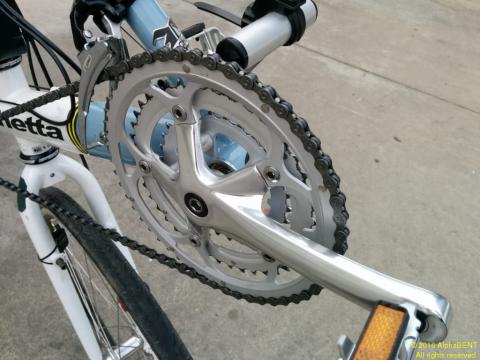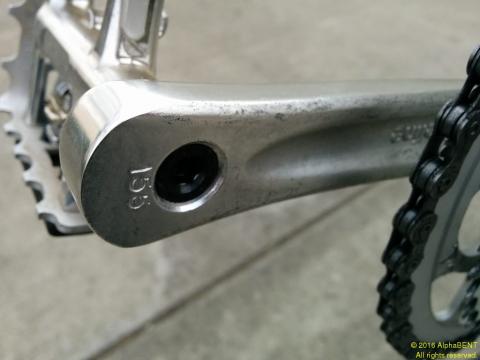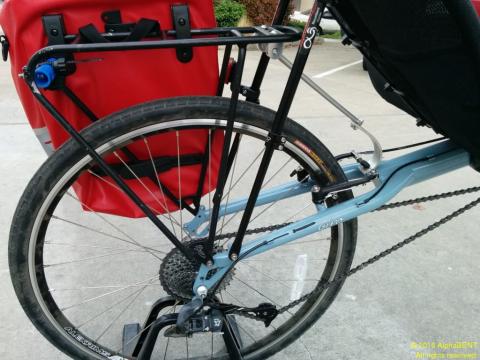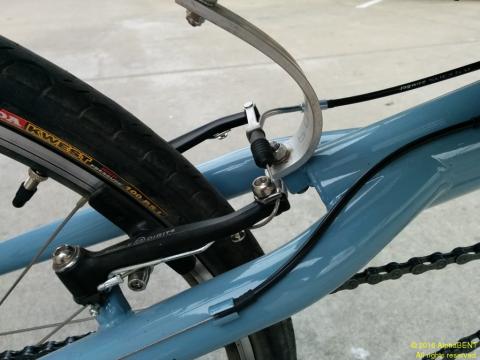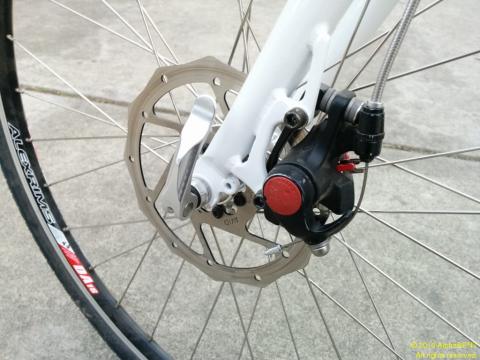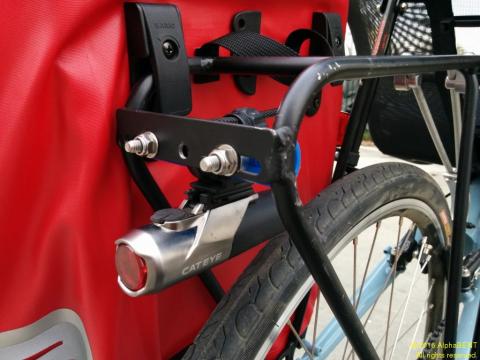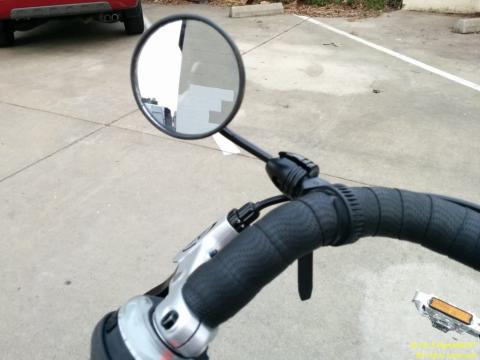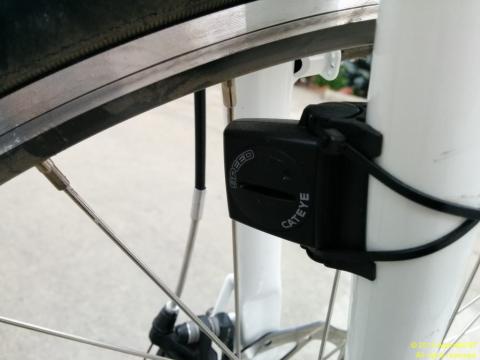A Catrike Trail E-Cat accessorized with a Shimano Alfine-8 drivetrain upgrade, Racktime rear rack with integrating basket, phone-mount, and extra mirror using AlphaBENT accessory mounts.
You are here
Bacchetta Giro 26 modifications
The Bacchetta Giro 26 is a great all-purpose bike. At $1700, qualifies as "entry level". It is quite similar to the ATT Giro 26 Bacchetta bikes, but it has a cromoly (CrMo) steel frame and cromoly (CrMo) fork.
The stock seat for this model is called the ReCurve with the key features of a mesh backing and perforated foam seat pan. It can be swapped with the lighter EuroMesh seat at no added cost. The Giro models come with pivoting steerer so the handlebar-knees distance is adjustable.
These are several changes we made to this Bacchetta Giro 26 and the reasons why:
Short (155mm) cranks
The stock crank is an FSA Tempo. It is big, ugly, and heavy and it has a conventional 170mm length. We put on a nice 155mm crank. This one single change saved ?? ounces of weight.
Since the main physical conflicts on a bike like this have to do with heel-strike and knee-handlebar interference, the shorter cranks give you a bit more breathing room.
Finally, the shorter cranks give a 10% faster cadence and 10% higher gearing for higher speeds.
We used our stock Durabi 400 cranks. We've been using these for years because they are a well-made, inexpensive, and consistent.
Front disc brake
As a matter of personal preference, some people prefer disc brakes over rim brakes. The main downsides to disc brakes are added cost and weight.
Because most of the braking force ends up on the front wheel, we balanced the cost-weight penalty by putting a disc brake just on the front wheel and leaving the stock rim brake on the back.
The Giro 26 come disc-ready from the factory -- meaning that the fork has disc brake tabs to mount the caliper and the front wheel uses a disc hub which accepts a disc rotor with no changes.
This all means that putting on a front disc brake is almost no more work than screwing in 6 bolts and swapping out the cable and housing for longer ones.
Clipless pedals
At AlphaBENT, we are self-confessed Pedal Snobs. Almost no bike seems complete without our X82 pedals. These pedals are a lot like the Shimano M324 double-sided pedals with one side dedicated to clipping in and the other side using a cage for regular shoes. However, the X82 has the following features and improvements:
- extremely light. There is no comparison with the M324 with regard to weight and the X82's are lighter than most SPD pedals of any brand or style
- sealed bearings: The sealed bearing cartridges require no maintenance and last a long time.
- SPD standard: like the M324, the X82 uses standard SPD-compatible cleats.
Rear rack
For any longer trip, commuting about town, or getting groceries, a rack is quite useful.
Bacchetta has solved the rear-rack problem with a general-purpose, highly configurable rack that seems to fit most of their bikes. We opted for a different rack for the sake of simplicity, lightness, and strength.
We started with an ICE Sprint 26 rack and fashioned a curved front anchor bar that bolts onto the caliper brake mounting point for the rear wheel. Given that the rear brake of this bike uses side studs, the caliper brake mounting hole is free and rated to a high strength so it makes an ideal anchor point.
All it took was to bend a sturdy piece of aluminum stock and drill three holes in it and we were done.
Light mounts
We are big advocates of bike lights. A rear flashing light seems light an indispensable safety feature. We fashioned a rear horizontal mounting bar using a piece of PEX tubing and bolted it to the inside of the back plate of the ICE rack. This allowed us to put on a Cateye Volt 50 with its massive battery for all-day flashing.
On the front, we used the tried and true Minoura Space grip, but the Bacchetta One-Armed Bandit has many advantages over it and would make a better choice for the long-term.
Kickstand
This bike does not like to stand up resting against a pole. Against a wall, yes -- pole, no. A kickstand is essential if you plan on standing it uphere and there.
Unfortunately, it is very difficult to mount a kickstand on this bike. Bacchetta makes a kickstand mounting bracket and we have found that it works well with a Pletscher ESGE kickstand on models like the Corsa. However, it is a challenge to get it to work well with this model in conjunction with a rack and / or fenders.
Steer bar flip
The fact that Bachetta is able to make the handlebar and steering work with so little interference with rider's knees is a wonder.
However, the presence of a conventional bicycle handlebar stem is a real head-scratcher:
- stem -- It is not clear why this bike has a stem. Given that it has a tilting steer bar with an adjustable angle and length, you can already place the handlebar position wherever you like. If the steer tube had a handlebar clamp at its end instead of a stem for a conventional bike, it would function just as well and there would be considerable savings of weight, parts, and cost.
- safe area -- When the handlebars turn, there is a central "safe area" where your knees have the most clearance. The further out from the center that your knees exist, the more likelihood you have to hit the handlebar with them. Therefore, it makes no sense for the stem (that doesn't even belong on the bike) to exist in the central safe area where the rider's knees move about.
- the bolt head -- There is a bolt head (on the stem which should not exist) and it is easy to hit that with your right knee.
The resolution to these problems is simple: flip the handlebar around. With the stem (which should not exist) elbow forward instead of backward, all of these problems went away other than the needless weight of the stem.
[It turns out that the ability to flip the stem around is dependent on the geometry of the bike, and this technique will not work "out of the box" with the Giro 20 since it takes the stop-bolt of the steering pivot beyond its intended / designed range.]
Mirror
We found that the Busch and Muller Cyclestar mirror mounts easily on the handlebar of this model and can be looked at while keeping the road in your peripheral vision.
Computer
The Cateye Urban wireless computer is pretty easy to install and handles the distance from the wheel sensor to the handlebar when place just so.
Image gallery
Information
A fire in the early morning of 5 June 2024 destroyed our neighbor business, MidCentury Sacramento. AlphaBENT escaped the worst of it and is back up and running.

